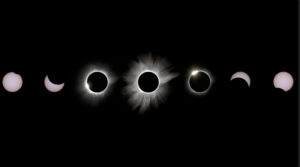The sun appears to rise in the east and set in the west. This happens because of how the Earth spins as it orbits the sun. If you are in space and look down on the North Pole, the Earth would appear to spin counterclockwise. It is that spin that makes the sun appear on the eastern horizon first and track west.
Viewed from this location in outer space, the moon also appears to move in a counterclockwise motion as it orbits Earth. It is this counterclockwise motion of the moon that causes its shadow during a total solar eclipse to move across Earth’s surface from west to east.
On Aug. 21, all of North America will witness a partial to full solar eclipse. The period of totality — when the moon blocks out most of the sun — will start around 10:15 a.m. Pacific Daylight Time (12:15 p.m. Central) along the northwest coast, occurs about 11:40 a.m. Mountain Daylight Time in central Wyoming and ends on the East Coast around 2:45 p.m. Eastern Daylight Time.
You have probably seen the sun reflected in a lake. This bright reflection is called sun glint. The same principle can be used to track the sun’s progress across the surface of the Earth if you’re in outer space (aboard a satellite, for example). The glint moves from east to west.
If you were on that same satellite during a total solar eclipse, you’d also see the moon’s shadow move across the Earth’s surface, but in the opposite direction.
You can see this phenomenon in a video made from satellite images taken during a total solar eclipse on March 9, 2016 at http://go.madison.com/eclipse-shadow. The video shows both the sun glint and the moon’s shadow as they trek across the western Pacific Ocean.
We will be tracking this month’s eclipse from the weather satellite perspective. You can follow along, and get other information, on our web page at: http://cimss.ssec.wisc.edu/education/eclipse-2017.
Steve Ackerman and Jonathan Martin, professors in the UW-Madison department of atmospheric and oceanic sciences, are guests on WHA radio (970 AM) at 11:45 a.m. the last Monday of each month.


